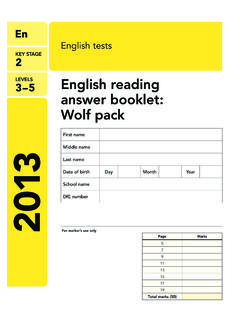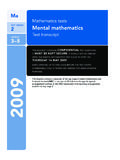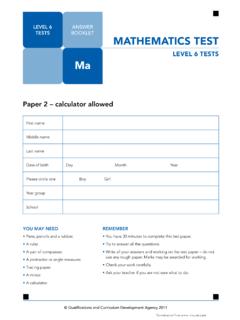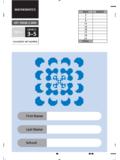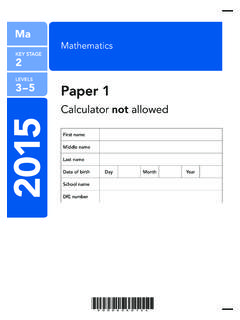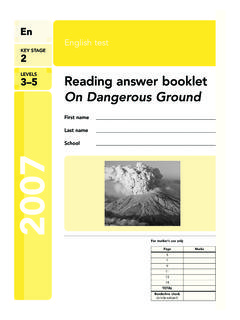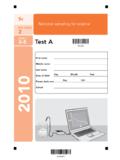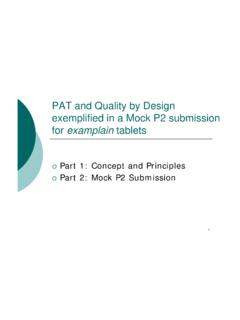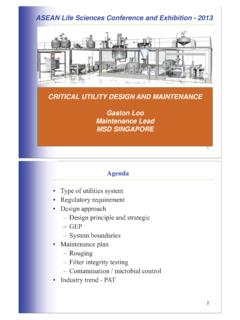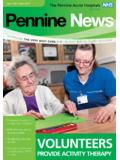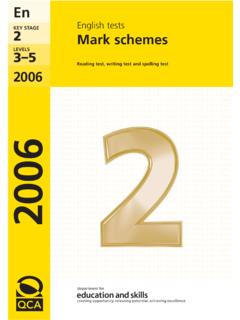Transcription of 264765 EnKS2 2005 MS - SATs Tests Online
1 20052 KEY STAGELEVELSEn2005 English testsMark schemesReading test, writing test and spelling test3 5 ContentsIntroduction3 The reading test4 The writing test29 The spelling test543 IntroductionAs in previous years, the external marking agency, under contract to QCA, will mark the testpapers. The markers will follow the mark schemes in this booklet, which are provided here toinform booklet includes the mark schemes for the assessment of reading, writing and spelling. Forease of reference, the test questions have been reproduced in the mark schemes. Level thresholdtables will be posted on the QCA website, , on Monday 20 marks in the Tests are allocated as follows:Reading50 Writing50 Longer task (including handwriting)31 Shorter task12 Spelling7 Total100 The mark schemes were devised after trialling the Tests with children and contain examples ofsome frequently recurring correct answers given in the trials.
2 The mark schemes indicate thecriteria on which judgements should be made. In areas of uncertainty, however, markers shouldexercise professional judgement based on the training they have received. The same sets of assessment focuses for reading and writing have been used for the English tasksand Tests at all key stages. These provide information about the particular processes or skills thechild needs in order to answer the questions. This information is provided in order to explain thestructure of each mark scheme as well as the way in which it will be used by external markers.
3 Theassessment focuses are drawn from the national curriculum and are directly related to the PrimaryNational Strategy. Diagnostic analysis of pupil performance based on the focuses can be generatedby using the Pupil Achievement Tracker (PAT) software available to download 2005 key stage 2 English Tests and mark schemes were produced by the key stage 2 Englishteam at the National Foundation for Educational Research (NFER) on behalf of reading testThe range of marks available for each question is given under the mark box in themargin of theReading Answer or unacceptable answers are given a mark of 0.
4 No half marks are are several different answer formats: short answersThese may only be a word or phrase, and 1 markmay be awarded for each correctresponse. several line answersThese may be phrases or a sentence or two, and up to 2 marksmay be awarded. longer answersThese require a more detailed explanation of the child s opinion, and up to 3 marksmaybe awarded. other answersSome responses do not involve writing and the requirements are explained in the mark scheme was devised after trialling the Tests with children and contains examples ofsome frequently occurring correct answers given in the trials.
5 These are shown in italics. Manychildren will, however, have different ways of wording an acceptable answer. In assessing eachanswer, markers must focus on the content of what has been written and not on the quality of thewriting, expression, grammatical construction, focuses for readingThe aspects of reading to be assessed are children s ability to:1. use a range of strategies, including accurate decoding of text, to read for meaning;2. understand, describe, select or retrieve information, events or ideas from texts and usequotation and reference to text;3.
6 Deduce, infer or interpret information, events or ideas from texts;4. identify and comment on the structure and organisation of texts, including grammaticaland presentational features at text level;5. explain and comment on the writers use of language, including grammatical and literaryfeatures at word and sentence level;6. identify and comment on writers purposes and viewpoints, and the overall effect of thetext on the reader;7. relate texts to their social, cultural and historical contexts and literary , describe,select or retrieve information, events orideas from texts anduse quotation and reference to , infer or interpret information,events or ideas from and commenton the structure and organisation of texts,including grammaticaland presentational features at text and commenton the writers use oflanguage, includinggrammatical and literary features at wordand sentence and commenton writers purposesand viewpoints.
7 And the overall effectof the text on the texts to their social, culturaland historical contexts and literary 2Q111Q121Q131Q142Q151Q162Q173 Section 3Q181Q191Q201Q211Q221Q231Q241Q251Q261Q27 a1Q27b1Q282Q292 Section 4Q301Q312Q321Q333 Total 102574405 The following table identifies the questions (with marks available) that address each assessment focus (AF).Assessment focus 1 underlies the reading of and response to the text and questions in the test, and is not explicitlyseparately assessed at key stage 2. Not all focuses will be appropriate to, or appear in, any one test at any given level.
8 FocusAF2AF3AF4AF5AF6AF7 Section 1: On the RoadSection 2: The Long DriveSection 3: On the PlainsSection 4: The whole booklet6 Section 1: On the RoadPage was Sharon s ambition?1 markAssessment focus 2:understand, describe, select or retrieve information, events or ideas from texts and use quotation and reference to 1 markfor answers which refer to driving the lorry and directly respond to the question,showing an understanding of the term ambition,eg: (she wanted) to be a lorry driver; lorry driving; drive a not acceptvague responses which are not a direct response to the question: eg (a)lorry did Sharon s friends and family eventually stop trying to discourage her?
9 1 mark Assessment focus 2:understand, describe, select or retrieve information, events or ideas from texts and use quotation and reference to 1 markfor reference to Sharon s determined attitude, eg: they realised that she was determined (to be a lorry driver); her mind was set on being a lorry not acceptreferences to the fact that Sharon had always dreamed of being a lorry driver (or paraphrases). the second paragraph, why are the wordsLarge Goods Vehiclein brackets?1 markAssessment focus 4:identify and comment on the structure and organisation of texts, including grammatical and presentational features at text 1 markfor responses which recognise that the words in brackets explain the abbreviation, eg: it s what LGV means; in case people wonder what it stands 4 (continued) at the diary entry for Monday at does Sharon s description make her cab seem like home?
10 Give to 2 marks Assessment focus 3:deduce, infer or interpret information, events or ideas from texts (simple inference).Award 1 markfor each reference to the domestic activities Sharon carries out in the cab or to the comfortof the cab, to a maximum of2 marks: sleeping, eg:she sleeps in the cab; reading, eg:she read a book; radio, eg:she s got a radio; television, eg:she watched the TV; eating, eg:she had soup in the cab; cooking, eg:she can cook food in her cab / she s got a microwave; phoning home, eg:she phoned the kids; comfort, eg:she says it s cosy / it s dry, safe and 1 markfor reference to general domestic equipment in the cab, eg:she s got what she needs to live in the up ferryMet Carl and for for the MotorwayUnexpected stop / indicator not working /checked bulb /drivers flashing / 12 noon /Le BoulouLunchmidday / the gaps in the table to show Sharon s to 2 marks Assessment focus 2.

